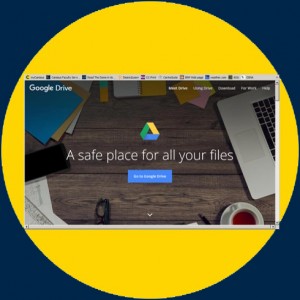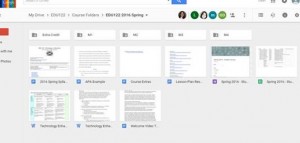 Faculty members across campus use a variety of electronic tools to aid in their teaching. One common tool is Google Drive, which allows the sharing of files among different faculty members, among students or between faculty and students.
Faculty members across campus use a variety of electronic tools to aid in their teaching. One common tool is Google Drive, which allows the sharing of files among different faculty members, among students or between faculty and students.
In the biology department, faculty use Google Drive to share drafts of homework assignments and quizzes that are used in multiple sections of a course. They also use it as an archive to store common files like lecture materials, course handouts, quizzes and homework assignments. In Dr. Jon O’Brien’s Freshwater Biology class (BIO377), students use Google Sheets (a spreadsheet similar to MS Excel) to share data on class projects and Google Slides (a presentation tool) to collaborate on group presentations to the class.
In Dr. Richard Reitsma’s Spanish composition course (SPA217), students work during class to translate passages from English into Spanish or vice versa. Dr. Reitsma can highlight mistakes, allowing students to determine the mistake and make additional edits. The class also can work on translations or edits as a group.
 Students in EDU122 (Technology in Education) are utilizing Google Drive to turn in and share assignments with their peers and their instructor. At the beginning of the term, students are taught how to organize their Google Drive space and create a folder for their class. They share this class folder with their instructor, Leah MacVie, who is then able to organize individual class folders in her own Google Drive space. Most assignments are created right in these folders using Google Tools, so there is very little “manual uploading” that takes place on the students’ parts.
Students in EDU122 (Technology in Education) are utilizing Google Drive to turn in and share assignments with their peers and their instructor. At the beginning of the term, students are taught how to organize their Google Drive space and create a folder for their class. They share this class folder with their instructor, Leah MacVie, who is then able to organize individual class folders in her own Google Drive space. Most assignments are created right in these folders using Google Tools, so there is very little “manual uploading” that takes place on the students’ parts.
Google Drive is an important tool for our future teachers to master since many K-12 districts are becoming Google districts themselves. Google Apps for Education provide many benefits for all students at Canisius, as well. If you are interested in using Google in your own class, please contact Leah MacVie or Mark Gallimore.
Submitted by: Sara Morris, PhD, associate vice president, academic affairs
